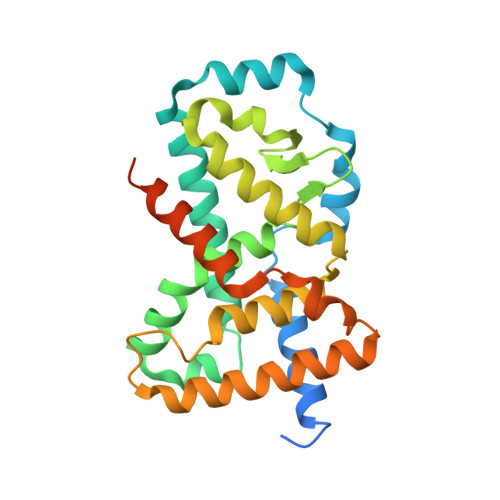Discovery of (3S,4S)-3-methyl-3-(4-fluorophenyl)-4-(4-(1,1,1,3,3,3-hexafluoro-2-hydroxyprop-2-yl)phenyl)pyrrolidines as novel ROR gamma t inverse agonists.
Jiang, B., Duan, J.J., Stachura, S., Karmakar, A., Hemagiri, H., Raut, D.K., Gupta, A.K., Weigelt, C.A., Khan, J., Sack, J.S., Wu, D.R., Yarde, M., Shen, D.R., Galella, M.A., Mathur, A., Zhao, Q., Salter-Cid, L.M., Carter, P.H., Dhar, T.G.M.(2020) Bioorg Med Chem Lett 30: 127392-127392
- PubMed: 32738966
- DOI: https://doi.org/10.1016/j.bmcl.2020.127392
- Primary Citation of Related Structures:
6XFV - PubMed Abstract:
A novel series of cis-3,4-diphenylpyrrolidines were designed as RORγt inverse agonists based on the binding conformation of previously reported bicyclic sulfonamide 1. Preliminary synthesis and structure-activity relationship (SAR) study established (3S,4S)-3-methyl-3-(4-fluorophenyl)-4-(4-(1,1,1,3,3,3-hexafluoro-2-hydroxyprop-2-yl)phenyl)pyrrolidine as the most effective scaffold. Subsequent SAR optimization led to identification of a piperidinyl carboxamide 31, which was potent against RORγt (EC 50 of 61 nM in an inverse agonist assay), selective relative to RORα, RORβ, LXRα and LXRβ, and stable in human and mouse liver microsomes. Furthermore, compound 31 exhibited considerably lower PXR Y max (46%) and emerged as a promising lead. The binding mode of the diphenylpyrrolidine series was established with an X-ray co-crystal structure of 10A/RORγt.
Organizational Affiliation:
Research and Early Development, Bristol Myers Squibb Company, Princeton, NJ 08543-4000, United States. Electronic address: bin.jiang@bms.com.















